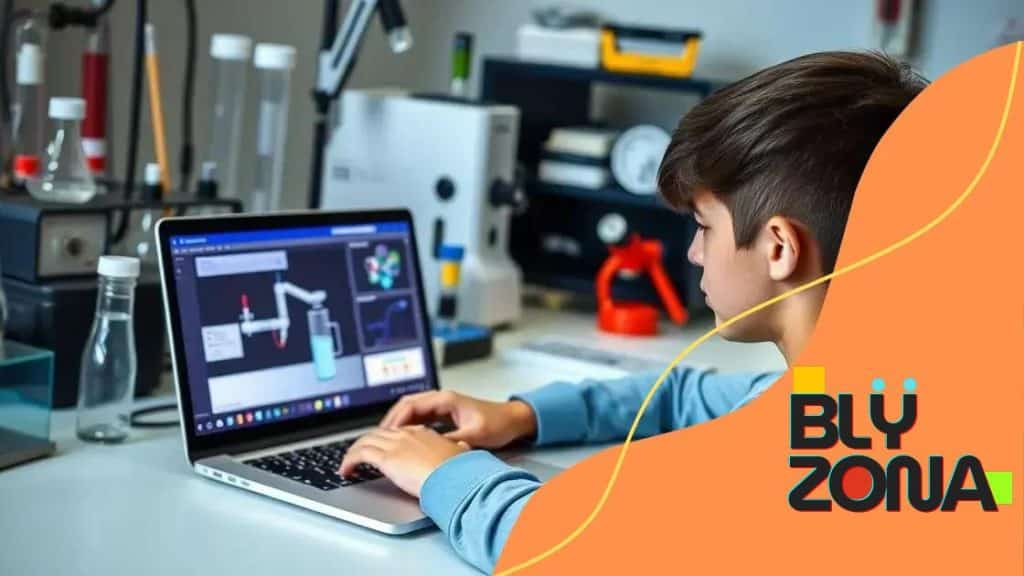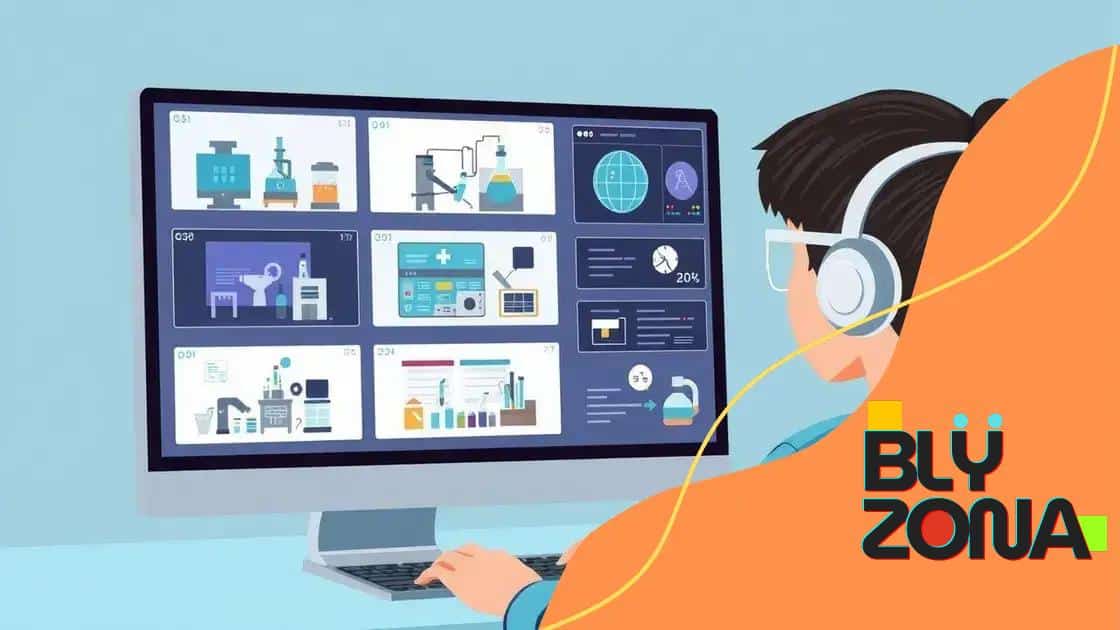Remote labs for science experiments: explore new frontiers

Remote labs for science experiments provide students with accessible, interactive environments to conduct virtual experiments, fostering hands-on learning while addressing challenges like technology access and ensuring effective implementation.
Remote labs for science experiments are changing the way students engage with science. Imagine conducting experiments from the comfort of your home! This article will delve into what remote labs are and how they can enrich your learning experience.
Understanding the concept of remote labs
Understanding remote labs is essential to appreciate their impact on education. These innovative platforms enable students to conduct experiments online, breaking traditional barriers that limit access to hands-on learning. Imagine being able to perform science experiments from your home, using sophisticated equipment and software found in professional laboratories.
Remote labs offer numerous advantages for educational institutions and students alike. With the ability to explore complex scientific concepts, students can engage more fully with their studies. They are not just passive learners; they are actively participating in the discovery process!
Key Features of Remote Labs
Some notable features of remote labs include:
- Accessibility: Students can engage with experiments at any time.
- Variety of Experiments: A wide range of scientific fields can be explored.
- Interactive Learning: Real-time feedback enhances the learning experience.
- Cost-Effective: Remote labs may reduce the need for physical equipment.
These features make remote labs a valuable resource in modern education. Students who may not have access to physical science labs due to geographical or financial constraints can still receive quality educational experiences. In addition, remote labs foster collaboration, allowing students to work together, even from different locations. This interconnectedness can lead to a larger appreciation of science and technology.
Furthermore, the technology behind remote labs continues to evolve, incorporating advanced simulation tools and real-time monitoring. As students work through experiments, they can collect data and analyze their results, gaining practical skills that are crucial in science. This approach not only builds knowledge but also confidence in scientific inquiry.
Benefits for Students
Engaging with remote labs provides students with the following benefits:
- Hands-on experience without the constraints of a physical lab.
- Increased motivation to learn through interactive platforms.
- The ability to learn from mistakes in a safe environment.
- Flexibility in scheduling experiments around personal commitments.
This blend of accessibility, interactivity, and engagement makes remote labs an integral component of future-focused education. By understanding the power of these tools, students can leverage technology to enhance their learning journey and prepare for careers in science and beyond.
Benefits of using remote labs for science experiments
Using remote labs for science experiments offers students a range of advantages that enhance their learning experiences. These platforms make science more accessible, allowing students to engage with complex experiments without being restricted by location or resources. This flexibility is crucial for fostering a deeper understanding of scientific concepts.
One of the primary benefits of remote labs is the ability to explore a variety of experiments. Students can choose from a wide range of topics, whether it’s chemistry, physics, or biology. This diversity keeps engagement high and encourages exploration in areas that might not be available in their local school labs.
Key Advantages
Some key advantages of using remote labs include:
- Increased Accessibility: Students can conduct experiments anytime, anywhere, especially important for those in remote or underserved areas.
- Cost-Effectiveness: Schools can save on physical lab materials and equipment, allowing funds to be allocated elsewhere.
- Real-Time Data Collection: Students can gather and analyze data instantly, enhancing their understanding of scientific methods.
- Safe Experimentation: Students can perform potentially hazardous experiments in a controlled digital environment.
Another notable advantage is that remote labs promote collaborative learning. Students can work together on projects, exchanging ideas and findings in real-time. This collaborative aspect expands their communicative and analytical skills, both of which are essential in scientific endeavors.
Moreover, remote labs often include simulations that mimic real-life procedures and scenarios. This hands-on approach allows students to practice and refine their skills, preparing them for future careers in science. The ability to experiment without the usual constraints fosters a deeper appreciation for the scientific process and cultivates curiosity.
This effective use of technology not only enhances learning but also encourages innovation. As students engage with cutting-edge tools, they become more adept at navigating the technologies that shape modern science.
How to access and use remote labs

Accessing and using remote labs is a straightforward process that opens doors to exciting scientific exploration. First, students need to find a suitable platform that offers remote lab resources. Many educational institutions partner with companies that specialize in these labs, providing students with guided access and support.
Once a platform is chosen, students typically need to create an account. This usually involves a simple registration process where they provide their details and agree to the terms of use. After registering, access to a wide range of experiments is granted, allowing students to explore various scientific fields from chemistry to physics.
Steps to Access Remote Labs
Here are the basic steps to access remote labs:
- Choose a platform: Look for reputable remote lab platforms that suit your educational needs.
- Create an account: Sign up by providing your information to access experiments.
- Select an experiment: Browse the available labs and pick the one that interests you.
- Follow instructions: Each experiment comes with guidelines that detail how to conduct the experiment.
Using remote labs is not just about access; it also requires understanding how to navigate the tools and features offered. Once inside, students can interact with virtual equipment, collect data, and even collaborate with peers. Most platforms include tutorials or help sections to assist users in becoming comfortable with the technology.
Additionally, students can monitor real-time progress and gain feedback from their experiments. This immediate response helps develop critical thinking and analytical skills. It allows students to refine their approaches and deepen their understanding of scientific principles. Interaction with virtual labs encourages exploration and curiosity in ways traditional learning may not.
Using Remote Labs Effectively
To maximize the benefits of remote labs, consider the following:
- Engage with tutorials: Take time to watch or read tutorials on how the remote labs work.
- Document findings: Keep a lab notebook to track experiments and results over time.
- Ask for help: Don’t hesitate to reach out to instructors or peers if you encounter issues.
- Participate in discussions: Engaging in discussions with classmates can enhance understanding.
This proactive approach to using remote labs can lead to a more enriching educational experience, allowing students to learn both independently and collaboratively.
Popular remote lab platforms for students
Many remote lab platforms are available for students, each offering unique features to enhance the learning experience. These platforms provide a wide range of experiments across various scientific fields, making them invaluable resources for students eager to explore science creatively and interactively.
Among the most popular platforms, some stand out for their user-friendly interfaces and comprehensive resources. Students can often find specific labs that align with their curriculum, making it easier to conduct experiments and grasp difficult concepts. Here are a few notable examples:
Top Remote Lab Platforms
- Labster: This platform provides high-quality simulations that cover numerous science subjects, such as biology, chemistry, and physics. Labster’s interactive approach helps students understand complex theories while maintaining engagement.
- Phywis: Catering specifically to physics, Phywis offers an array of remote experiments that allow students to test principles from the comfort of their home. It is a valuable tool for visual learners who grasp concepts better through practical demonstrations.
- Virtual Labs: This website includes various scientific resources, giving students access to multiple experiments and activities. It covers topics in chemistry, biology, and physics, making it a versatile choice for educators and learners.
- Science Lab: Known for offering interactive, web-based experiments, Science Lab allows students to learn at their own pace. The platform includes detailed instructions and simulations, promoting a deeper understanding of scientific processes.
Each of these platforms emphasizes interactive learning. They allow students to make mistakes, analyze outcomes, and learn from experience in a safe virtual environment. This aspect is critical for building confidence in students as they navigate scientific procedures.
Students using remote labs also benefit from the ability to collaborate with peers in real-time. Many platforms include features that enable discussions or group work, which promotes teamwork and builds communication skills necessary in scientific fields.
Choosing the Right Platform
When selecting a remote lab platform, it is essential for students to consider their needs and interests. Look for platforms that align with specific subjects or experiments of interest. Additionally, consider ease of use and the availability of support resources.
In conclusion, with so many platforms available, students can easily access quality scientific education through remote labs. These tools not only facilitate learning but also inspire curiosity and innovation in the field of science.
Challenges in implementing remote labs effectively
Implementing remote labs effectively comes with its own set of challenges that educators and students must navigate. While these platforms provide great opportunities for learning, there are obstacles that can hinder their success. Understanding these challenges helps in finding effective solutions and ensuring a smooth educational experience.
One of the most significant challenges is the lack of access to reliable technology. Students may find themselves in environments where internet connectivity is weak or devices are outdated. This can limit their ability to fully engage with the remote labs. Without a dependable internet connection, completing experiments or accessing necessary resources becomes difficult.
Common Challenges
Some other common challenges faced during the implementation of remote labs include:
- Technical Difficulties: Issues with software or bugs can disrupt experiments, leading to frustration and loss of interest.
- Training and Support: Not all students and educators are familiar with using digital platforms. Adequate training is essential to ensure everyone knows how to navigate these labs effectively.
- Engagement: Keeping students motivated in a virtual environment can be challenging. It’s important to cultivate interactive elements to make learning enjoyable.
- Curriculum Integration: Aligning remote lab experiments with existing curriculums can be complex and requires planning.
Additionally, some students may feel isolated when working alone on experiments. Collaboration is an essential part of learning, and without it, some students might miss out on important discussions and interactions that enhance their understanding.
Another challenge is ensuring equity among students. Some may have a better learning environment or more resources than others, leading to disparities in learning outcomes. This calls for a thoughtful approach to resource distribution and access to technology.
Addressing the Challenges
To overcome these obstacles, schools and educators must take proactive steps. Providing reliable access to technology is critical, as is offering support and training for both students and teachers. Encouraging collaboration through online platforms can foster a sense of community. Making resources available, such as tutorial videos and help desks, can further assist students in overcoming hurdles they may face.
By acknowledging and addressing these challenges, the effectiveness of remote labs can be significantly improved, leading to more fruitful learning experiences for students.
FAQ – Frequently Asked Questions about Remote Labs for Science Experiments
What are remote labs?
Remote labs are virtual platforms that allow students to conduct scientific experiments online, providing access to equipment and simulations.
How do remote labs enhance student learning?
Remote labs provide interactive experiences that engage students and help them understand complex concepts through hands-on practice.
What challenges might students face when using remote labs?
Students may encounter issues such as limited internet access, technical difficulties, and the need for adequate training and support.
How can educators assist students in using remote labs effectively?
Educators can provide training, ensure reliable access to technology, and encourage collaboration among students to enhance the learning experience.





